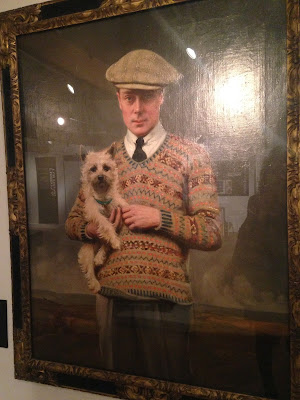All photographs taken
at the exhibition on 06/11/15
British fashion has a rich tailoring heritage and could even
be considered as the ‘basis’ for Fashion design today. The Tailored – A very British
Fashion exhibition has made me aware of the significance of tailoring in
fashion, the icons that influenced tailored design and cultural influences that
encouraged tailored styles to change and adapt.
Tailoring is a renowned British skill, made famous on London’s
Saville Row, which then flourished, dressing ordinary men and women across the
country for much of the twentieth century.
Above: Tailoring timeline – 1600 to 2015
Tailored suits for men began to be made from the end of the
1600’s using methods of cutting and measuring cloth to closely fit the body. By
the end of the 1700’s English tailors had become the leaders of menswear, due
to the trend of well-made country coats. The following image demonstrates how
tailors began to add shape to wool suits for a fashionable purpose.
Above: 1770-1780’s Suit
Wool cloth was often used to create suits and tailored
clothes, which influenced later designers to develop alternative fabrics and
finishes.
Above: A ‘fashionable’ boys suit (worn in upper-class
families after children were ‘breeched’ at the age of four), made of silk with
silver thread embroidery and buttons.
Above: 1835 wool, cotton and silk suit-jacket with a ‘lark’s
tongue-notch’ lapel. It was designed to show the waistcoat, shirt and cravat
underneath. The flamboyant style presents the tailors art, for a fashionable
1820’s gentleman.
Above: ‘Barfoot’ Blazer, 1900. Brightly coloured blazers
originated in English rowing clubs in the early 1800’s. This casual,
lightweight style was designed for leisurewear and adopted for playing cricket.
It was particularly interesting to see how tailored styles,
first of all intended for men, seeped into the womenswear market after 1800’s women’s
rights movements. The style of suits we know today were made not only made to accommodate
women, but adapted in style to accommodate movement for popular leisure
activities such as horse riding.
Above: Legg & Millard – Women’s ‘Riding Habit’ -
1880-1890. Adapted from a 1600’s style.
The association of tailoring and work wear developed in
mid-1800 then the suit became a typical uniform for men and women. Men wore matching
wool suits, unless they worked as labourers, and women wore tailored jackets
with skirts to mark their position in the workplace. Pin-stripe cloth became a
popular trend associated with office-wear.
Above: W.R. Dargie, Pinstripe Skirt Suit, 1932. Wool.
Until the 1850’s, brands such as Saville Row (London)
produced tailored clothing that was bespoke-measured to fit the wearer. When
clothes began to be factory produced, brands such as Hepworth’s and Burtons
introduced ‘made-to-measure’ suits which were measured in-store but produced in
factories - the birth of ‘ready-to-wear’ suits we see today.
It is interesting to
compare the development and adaptation of tailored items to what we see today.
Tailoring now takes a multitude of forms (shirts, jackets, skirts) and can be
worn for any activity due to relaxed design and casual standards of dress in
modern life. Throughout the ages, tailored items remain a symbol for conformity
(which became popular with subcultures such as Teddy Boys and Mods adopting tailored
styles as uniform). Their powerful connotations encourages designers to play
with the structure of ‘tailored’ items, turning a craft into something quite
abstract.
Above 1: Vivienne Westwood ‘Winter’ outfit, Autumn/Winter
2000. Felted Polyester & Viscose.
Above 2: Hardy Amies for Hepworth’s ‘Teddy Boy’ Jacket,
1972. Wool & Polyester.
Vivienne Westwood is an example of a designer who is known
to explore the craft and history of British tailoring. She has dared to questioned
the structure of ‘classic’ styles of tailoring by twisting and shifting the
patterns into fluent shapes.
Above 1: HRH Prince of Wales by John Saint-Helier Lander,
1925. Oil on Canvas. Edward, Prince of Wales became a style icon for ‘sport’
styles of tailoring.
Above 2: Scholte, Foster & Son Suit, 1932. Style icon
Edward, Prince of Wales popularised ‘tweed’ suits with a zip-fly, which was uncommon
for formal wear.
Around 1900, with the invention of the tape-measure, the art
of tailoring was improved and ‘fits’ became better than ever. The Upper-class began
to wear tailcoats and dinner jackets for evening wear or special events.
Above: Blades – Velvet and Silk Evening Suit – 1967. In 1962,
London store Blades designed innovative suits in luxurious fabrics which
appealed to young men during the ‘peacock revolution’.
In 1964, Leeds multiple tailor Hepworth’s celebrated their
centenary. Fashion designer Hardy Amies collaborated with Hepworth’s in
collaboration and the company donated £20, 000 to the Royal College of Art to
establish the first menswear design course (Leeds Museum, 2015).
Above: Coverage of the
Hepworth’s designs at the Savoy Hotel show in London, 1964.
The following images illustrate two different
interpretations of tailoring, both developed from the original uniform-like
style which originated around 1600. With the many possibilities of design
technology and textiles, it will be exciting to see how (or if) designers will
continue to interpret classic tailoring in the future.
Above: Roger Saul Suit, 1979. Cotton. This outfit from Mulberry’s
Spring 1970 collection demonstrates the relaxed and informal trend of tailoring
as designers experiment with structures (Leeds Museum, 2015).
Above: Vivienne Westwood, 'Morning Glory' Suit, Autumn/Winter
2015. The striking Tartan pays homage to British Heritage and signifies the
importance of British tailoring to Westwood’s brand.




















No comments:
Post a Comment